May 11th, 2012 by Marc AuMarc
Right now there are killdeer (Charadrius vociferus) nests all over St. Martin, in fields and on mudflats. In most cases I’ve seen, the nest just a small bowl of bits of stone or shell on the ground with two to four eggs inside. Although the nests seem obvious in the photos below, they can be very hard to spot, and could easily be trampled.
The easiest way to find a killdeer nest is to keep an eye out for the parents. They will make alarm calls and put on quite a show to distract you from the nest, including the old broken wing act and another move where they stick their butt in the air. I guess you could call that move the killdeer back-end.
Although the birds are comfortable nesting around human activity, the nests themselves are quite vulnerable, so it is important to be very careful if you are traveling in a potential nesting area, particularly if there are adults exhibiting these behaviors. Below are some photos of nests and the parents guarding them with their distraction displays.
Posted in Les Fruits sur la Terre, Pour les Sciences
Comment on this post.
April 23rd, 2012 by Marc AuMarc
A dying Anguilla Bank anole (Anolis gingivinus) provided an interesting case study in how anoles manage territorial disputes. After discovering a sick anole that was emaciated, listless and likely close to death, we took it from the beach to a perch on a nearby tree. Of course, any viable perch is usually occupied by another lizard. In this case, a nearby female began to threaten the “intruder” by bobbing its head and extending its dewlap. Too tired to move, the sick lizard didn’t respond to these signals and the healthy anole escalated the conflict.
Typically, after an initial confrontation the weaker lizard would immediately move on to another location, but the sick lizard was largely immobile. The healthy lizard repeatedly attacked and probably would have continued to do so indefinitely had we not moved the sickly anole. It was interesting to see the reaction of the healthy lizard when the traditional rules of combat were not in play.
The photos below showcase a few interesting things. First, of course, is the unusual appearance of the sickly anole. I couldn’t say what caused its condition. It could have some sort of disease, infection or internal injury or perhaps could have been poisoned by eating insecticide laden insects. The photos also show a healthy female anole displaying aggressive coloration and territorial defense behavior.
As far as the ethics of the situation, I’m not sure there were any great solutions. The lizard was clearly dying, but we found that any available perch was inevitably part of an already occupied territory. Leaving an immobile lizard in the sun would result in it being eaten by a predator or dying of overheating. It may have been best to kill the lizard as painlessly as possible, but that didn’t occur to me at the time. In the end it seemed reasonable to document the behavior and try to find an unoccupied perch but ultimately let the situation work itself out naturally.
Posted in Les Fruits sur la Terre, Pour les Sciences
Comment on this post.
April 5th, 2012 by Marc AuMarc
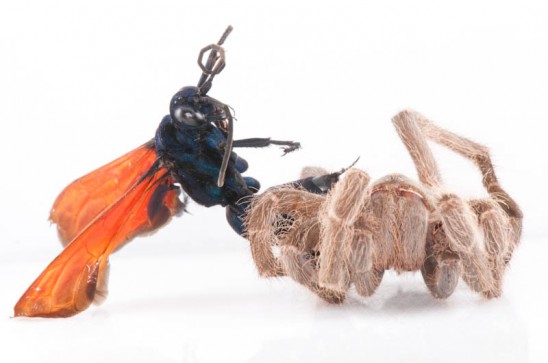
This fantastic specimen shows two formidable foes caught forever in their mutual destruction. The wasp (Pepsis rubra) is from a group known as tarantula hawks, which hunt and paralyze tarantulas, bringing them to their burrows as food for their larvae. Typically an egg is laid on the tarantula and the larva eats the paralyzed host. The tarantula (probably Cyrtopholis sp.) is also a venomous predator.
In this case, it seems each was able to kill each other, and they remained joined in death with the tarantula’s fangs gripping one of the wasp’s legs.
Bonus: The oleander caterpillar moth (Empyreuma affinis) is a wasp-mimic that mimics Pepsis rubra.
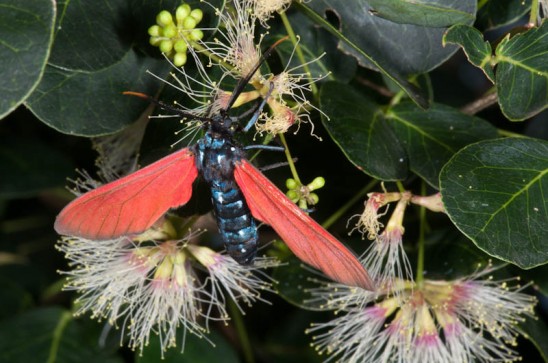
Posted in Les Fruits sur la Terre, Pour les Sciences
Comment on this post.
March 11th, 2012 by Marc AuMarc
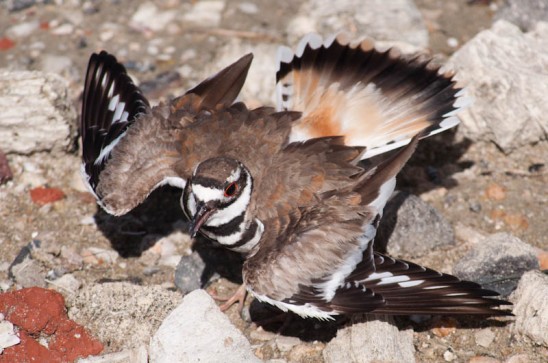
The salt flats surrounding Salines d’Orient serve as a nesting ground for several species of bird, and apparently the nesting season has begun. This killdeer (Charadrius vociferus) is brave enough to try to distract and intimidate humans near its nest, even though we are hundreds of times larger than it is. Camouflaged eggs and a dedicated parent are the only protection for a nest on the ground, and unfortunately, few chicks in the area survive until adulthood. Predators include mongoose and dogs, and the barely noticeable nests are also easily trampled by humans.
If you are in the area this time of year, it is best to avoid walking on the salt flats, or to do so very carefully, and keep dogs on their leash. This will at least give these brave birds a fighting chance to raise their young.
Posted in Les Fruits sur la Terre, Pour les Sciences
Comment on this post.
March 2nd, 2012 by Marc AuMarc
A couple weeks ago, I went with St. Martin Trails to clear some of the Crest Trail near Reward on the Dutch side of the island. After a couple hours of clearing trail, I found that the next portion of the Crest Trail was pretty clear so I decided to walk over to Paradis to meet friends at Loterie Farm.
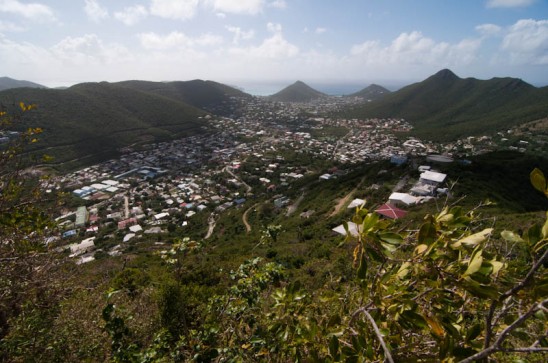
The views were spectacular, and I believe that part of the trail that runs along an old slave wall may actually also be running along the border between the two nations on the island. There was also plenty of wildlife to be seen, including many tree frogs, the beautiful black witch moth and my first sighting of the zestos skipper. On the way down to Loterie Farm, I also passed the remains of the Sucrerie Loterie, sitting in the forest that has grown up around it since the days of colonial agriculture.
Posted in Explorations, Les Fruits sur la Terre
Comment on this post.
March 1st, 2012 by Marc AuMarc
Tucked away between Maho and the Simpson Bay Lagoon is a nice strip of scrub running along Pointe Pirouette. While killing some time between dropping off and picking up friends at the airport, I explored the overgrown dirt tracks that cut through the scrub and found a variety of interesting invertebrates.
The coolest thing I found were some debris-carrying lacewing larvae. These hunters camouflage themselves with various debris, including the exoskeletons of their prey. There were also plenty of stink bugs, katydid nymphs and fuzzy green weevils. Although the area may not be as beautiful or species-rich as some areas of the island, it’s a lovely, and accessible patch of scrub in an otherwise largely-developed area.
Posted in Explorations, Les Fruits sur la Terre
Comment on this post.
March 1st, 2012 by Marc AuMarc
There are few cases when manmade construction actually preserves habitat, but on occasion it does happen. On a recent visit to Fort Amsterdam, I had the pleasure of seeing brown pelicans building their nests on the nearby cliffs. Although it’s impossible to know for sure, it definitely seems likely that if there were no ruins of Fort Amsterdam, the area would have been developed for tourism and the pelicans wouldn’t be nesting there. A win-win for history and natural history on the island.
Posted in Arts & Culture, Les Fruits sur la Terre, Pour les Sciences
Comment on this post.
February 23rd, 2012 by Marc AuMarc
Right now, there are very few birds in many parts of Salines d’Orient, but birds can be found by exploring the mud flats that are often covered in water during wetter times. Below are some photos from visits over the last week, including several of black-necked stilts and Hudsonian whimbrels.
Soon, with the start of the nesting season, this area will be home to very well camouflaged bird nests, so walking around there is not recommended. Of course, having seen mongoose there recently, humans aren’t the only threat to these nests.
Posted in Les Fruits sur la Terre
Comment on this post.
February 23rd, 2012 by Marc AuMarc
There aren’t a whole lot of different butterflies on St. Martin, around 30 species compared to perhaps 1,000 insects total. After not seeing any new butterflies for many months, I saw two new ones in about a week.
The first was along the Crest Trail between Mt. Flagstaff and Pic Paradis. The Zestos skipper (Epargyreus zestos) is fairly large for a skipper, and a lighter brown than other species on the island of a similar size.
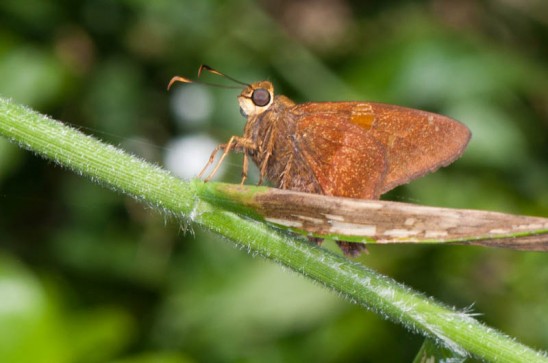
The other skipper was also in the highlands, between Hope Hill and Pic Paradis. The dark longtail (Urbanus obscurus) would be easy to overlook, as it looks similar to a couple more common species, the hammock skipper and the long-tailed skipper. Up-close, it is pretty easy to distinguish, as it has fewer markings, and its tails are halfway between the little stubs of the hammock skipper and the very long tails of the long-tailed skipper.
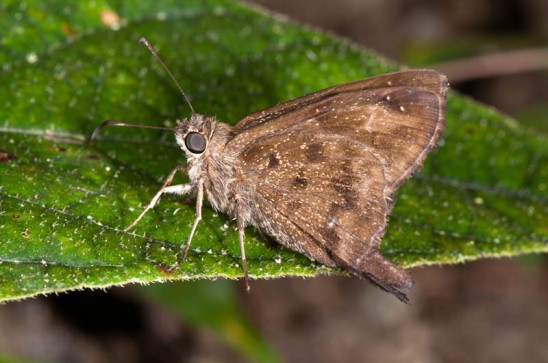
Posted in Les Fruits sur la Terre, Pour les Sciences
Comment on this post.
February 18th, 2012 by Marc AuMarc
Today I had a fantastic hike from Hope Estate to Pic Paradis via the freshly-cleared Careta Trail. The trail is shady and much more pleasant than the dirt road. I also found three species that I hadn’t ever seen on the island before, including two spiders and a scorpion. Definitely a big day for me! There were also many iridescent jumping spiders, dwarf geckos, tree frogs and many other small and wonderful creatures. I even saw a scaly-naped pigeon, which is a fairly rare sight on the island.
Posted in Les Fruits sur la Terre
Comment on this post.

























































































































































